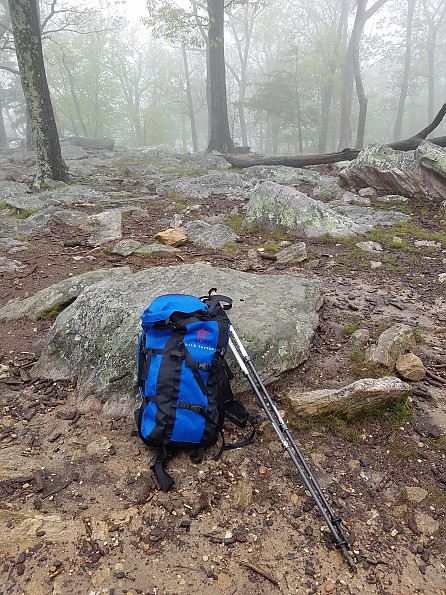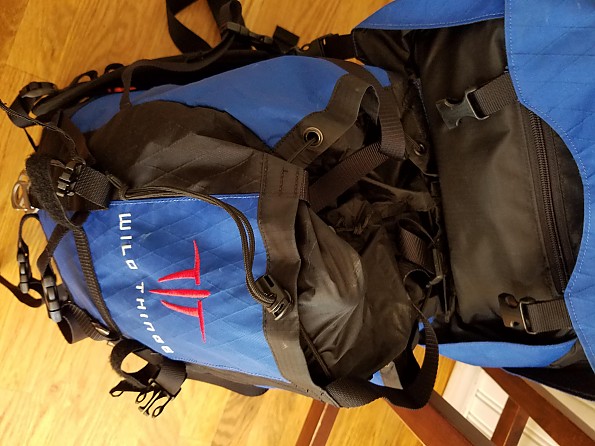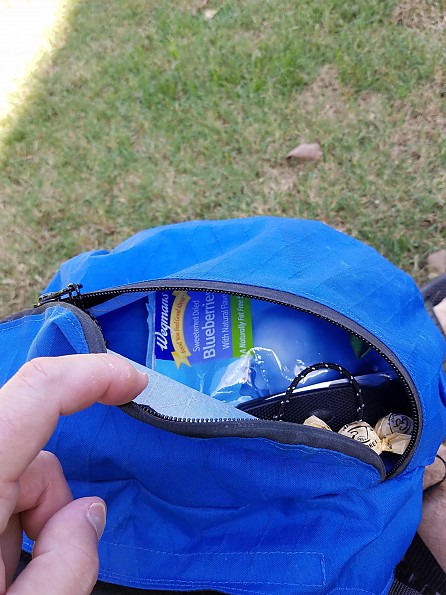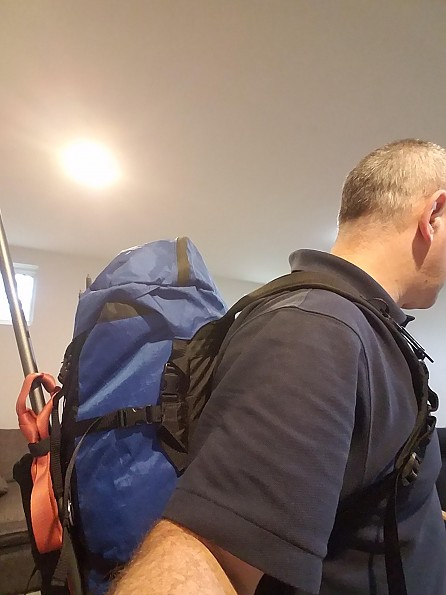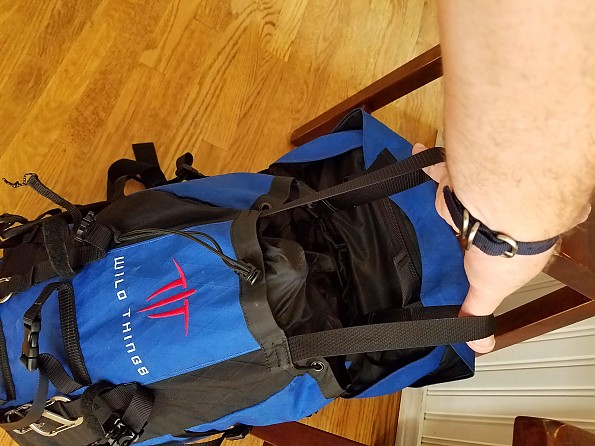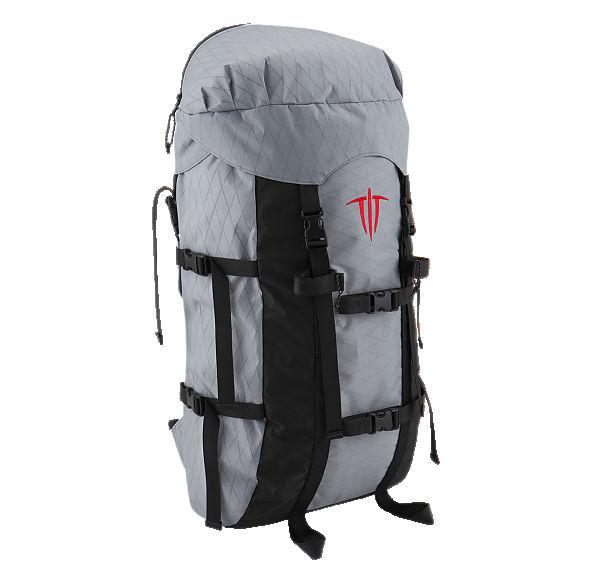Wild Things Guide Pack
The Guide Pack has been discontinued. If you're looking for something new, check out the best daypacks for 2025.

This light, old-school day pack is great for people who want a low profile pack with plenty of tie-down options. Made for climbing, this pack should prove to be very durable. It has light but very comfortable shoulder straps and a removable lid and back pad for those who want to minimize weight. Unpadded hip belt and crude hydration accommodations might not thrill some people.
Pros
- Simplicity
- Tie-down options
- Comfort
- Likely durability
Cons
- Cost
- No padded hip belt
- Limited pockets
I purchased the Guide pack a year ago because most of my 'day' packs were larger, heavier, and made to carry more weight. This pack also fit a need for something to take up mountains in the winter after dropping my large backpack. Overall, I have been very happy with it.
Basic Details
The Guide Pack holds 1600 cubic inches/26 liters and weighs 1.8 pounds (28.8 ounces) on my digital hand scale. It is a top-loading pack with a lid that has two small pockets. It has no frame; there is a small closed cell foam pad that lies next to your back. The 'sleeve' that holds the back pad can be unzipped to remove the pad, or alternatively to hold a hydration bladder.
The lid is attached to the bag via a hook/loop strip and nylon straps with plastic clips — it is easy to remove. The top closes with two cords, one around the circumference of the top, the other around the circumference of the small nylon extension sleeve. The hip belt is a one inch unpadded nylon strap that can keep the back from moving around but won't support much weight. Each side has two compression straps — it's very easy to shrink this down if needed.
The bag is made from VX-21, a 200d nylon fabric laminated with polyester threads. It's a relatively stiff fabric that has proved to be very durable on another backpack I own.
This shows the top of the pack with nylon cord laced through grommets on the top. Even with the lid removed, the two top cords keep things in place.

Side view shows the compression straps and a few things attached to the back.

The shoulder straps are thinly padded but very comfortable, provide you keep it below 20 pounds. I have carried a max of 25, which felt heavy and edging toward uncomfortable.
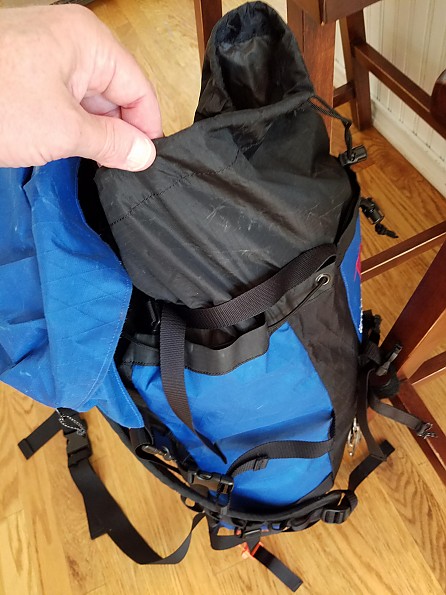
A small nylon skirt extends the capacity slightly.
Storage and Tie-Down Options

The main pocket in the lid is pretty small. It will hold a small cap, light gloves, snacks, and a few other things. There is a very thin zippered pocket underneath, good for a knife, phone and thinner wallet.
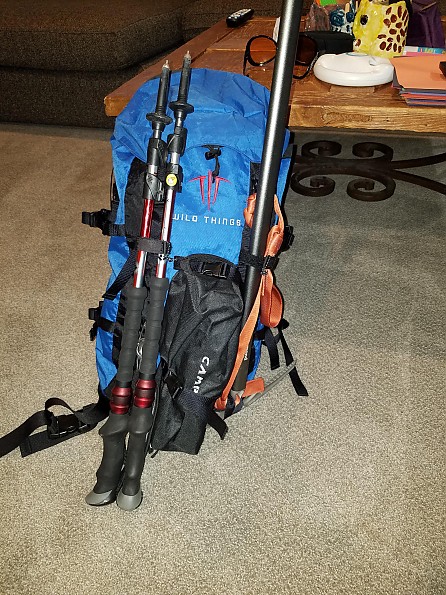
As you can see from this photo and others of the back, the backpack has two daisy chains that run down the back, two straps across the front (that are holding my crampon bag in this photo), two ice axe loops, and two hook/loop closing small straps (you can see them holding the ice axe and trekking poles in place here).
Side view with things attached to the back. I carry a couple of s-biners on each daisy chain to use with bungy cords or straps if needed — that's how i would secure snowshoes, for example.
The pack has two straps with plastic clips attached near the top opening. I quit rock climbing years ago, but the straps are clearly meant to secure a rope across the top. I have used them a few times to strap down a wet rain jacket. This photo also shows the top strap in the middle to hold a pair of crampons.
Hydration — It's OK
The sleeve that holds the foam back pad unzips and can accommodate a 3 liter hydration reservoir. The snow skirt has a small opening for a hydration tube. That is essential. On one hike, I forgot to loop the hose through that hole, and the hose became kinked, wouldn't work.
You're on your own getting the hose secured to the shoulder strap — nothing dedicated to that. I either use the small included clip that Platypus has or use an s-biner to secure the hose to either shoulder strap. People who focus on the ease of use of the hydration will find this system to be pretty rudimentary. There are better options.
Durability
Stitching and straps are heavy-duty. After a year of use, no blow outs or failures. The pack fabric is tough but readily shows scuffs from rocks. No tears, just marks, but extended time rubbing against rocks might do some damage to the nylon. It would take a lot to damage the polyester straps laminated to the outer fabric. The haul loop on the top is very secure.
How I Have Used It
This became my primary day pack a year ago, provided I didn't need to carry gear for others. That means hikes up the Shenandoahs, along (and sometimes in) the Potomac River and adjacent trails, and up local small peaks in Maryland and Virginia, as well as many day hikes on various local trails. I rarely carry more than 18 pounds with this, and it is quite comfortable for that. In a pinch, you could carry 25 or even 30, but this wouldn't be my choice for those higher weights due to the lack of a frame and suitable hip belt.
For the basic functions a daypack serves — carrying stuff comfortably — this is a great backpack. The ability to attach things to the exterior is very good, though you tend to see that on climbing-oriented packs like this.
Because it is so simple and lacking in exterior pockets, people who like easy access to small things via hip belt pockets or exterior side pockets won't like this and might be better served by a pack like the Osprey Talon 22, which I looked at as an alternative. Also, the back is made of the same nylon/polyester fabric as the body, so it doesn't breathe or disperse moisture. There are lots of daypack alternatives that have mesh or trampoline backs that handle moisture better, if that's something you care a lot about.
The fabric is highly water resistant. Occasional showers won't dampen the interior. After spending a full day outside in on-and-off rain, some moisture got in.
$195 is expensive for a backpack this size — that presumably has to do with the more durable materials and work that goes into a climbing-oriented pack with all the attachments options. For example, I peeped the Cilogear 30 liter Worksac as an alternative, and the cost was comparable to this. On the other hand, the very nice Osprey Talon 22, a more traditional daypack, lists at around $100. I saw this at 30% off, which made it more appealing.
Conclusions
A light, well-sized daypack that comfortably carries the kind of load you would expect for a 26 liter pack. It should be durable and offers a lot of exterior attachment flexibility. Simplicity and lack of exterior pockets, frame, and hip belt may be a plus or minus, depending on what you like.
Source: bought it new
Price Paid: $138
As a ski mountaineer/alpinist this is the perfect day pack. It follows the tried and true design of a good pack, top loading, two compression straps, and removable lid.
The weight is what sold me, it's light. Remove the lid when you need less space and it's even lighter. The fabric isn't going to last a lifetime but it'll take a heavy beating when skiing trees or hauling it while climbing.
Being fairly tall, it would be nice to have a longer version, but it still fits great. The waist strap is perfect, not too wide or overly padded. Being such a light pack, little features weren't left out. There is a whistle, 2 draw cords instead of 1, haul loops on the shoulder strap, zipper under the lid, 2 clips to tie down crampons or a rope under the lid, etc.
Someone mentioned in doesn't have gear loops and well yes, it lacks that, but I find gear loops get in the way of my skis when I have them on my pack and a compression strap can double as a gear loop. If your wearing your harness or a gear sling, then the problem is obsolete.
Overall I greatly recommend this pack. Is it worth 175$? Well, if you're serious about mountains, I don't think that question should even cross your mind.
Bought mine at wildthingsgear.com
Price Paid: $175
Your Review
You May Like
Specs
| Price |
MSRP: $195.00 Reviewers Paid: $138.00-$175.00 |
| Weight |
28 oz |
| Volume |
1600 cu in / 26 L |



